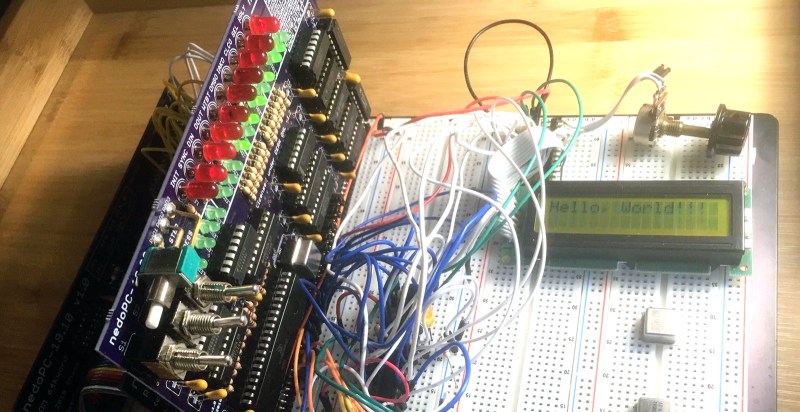Digital Equipment Corp.’s PDP-11 is one of the most important computers in history. It’s the home of Unix, although that’s arguable, and it’s still being used in every application, from handling nuclear control rods to selling Ed Sheeran tickets on Ticketmaster. As the timeline of PDP-11 machines progressed, the hardware did as well, and by the time the PDP was eclipsed by the VAXxen, there were PDP-11s on a single chip. The Eastern Bloc took notice and produced their own PDP-11 on a chip. This is the 1801-series CPU, and like most soviet electronics from the Cold War, they’re readily available on eBay.
[SHAOS] has an interesting project in mind for this PDP-on-a-chip. It’s a standalone computer built around the Soviet re-implementation of the PDP-11, built into a form factor that could be described as a single board computer.
This project is the outgrowth of [SHAOS]’ project for last year’s Hackaday Prize, the PDPii. This was a computer built around a backplane that replicated the PDP-11 using a KR1801VM2 CPU, the Soviet not-a-clone clone of the PDP-11. This project is basically a PDP-11/03 system, except it was made in this century, and you can put it in any computer case, with bonus points awarded for RGB lighting and liquid cooling.
This year’s project, the PDPjr, eschews standardization to something that is far more unique. This build is more or less a single board computer with a character LCD display and a real keyboard. Think of this as the PDP-11 equivalent of the TRS-80 Model 100, a machine widely regarded as being the first laptop.
There’s still a lot of work to go, but [SHAOS] has written a ‘Hello World’ for this chip, and is getting those words to display on the character LCD. That’s a great first step and we can’t wait to see where this project ends up.


















I hope this year I will finally finish the project :)
I hope so, this is awesome! Are you making a case for it?
No case – just board by itself :)
And technically speaking it is not a “single board computer”, but more like 3+ board computer – it will use CPU board and RAM board from #PDPii project and will have 1 extra BBQ-slot for future IO boards ;)
“and will have 1 extra BBQ-slot for future IO boards ;)”
So, when you want to BBQ, (barbeque) will you have to remove the I/O board? Or will you be able to leave it in? Would you be able to baste the meat, or will that short out the other boards?
B^)
You should eat it as is :)
BTW initially I wanted to call it BBFQ-bus (Bread Board Friendly Q-bus), but then I was told that BBQ-bus sounds better ;)
Excellent projects, both of them! PCB autorouting from a netlist sounds great too – we cooked up a netlist based flow with Eagle for beeb816, but that’s not an open source tool. Knowing that you can simulate exactly what you’re fabricating is a big win.
Thanks! For now everything is manually drawn :)
But I know already how I will do auto-routing in similar fashion programmatically – I just need to find spare time to sit and write C-program that is doing that ;)
>> PDPjr, … and a real keyboard.
If you call it jr, it should come with a chiclets keyboard.
(when I read “1801” I thought Soviet? you mean RCA”)
Yeah, I thought of the RCA chip as well
Why is it “arguable” that PDP-11 was home for Unix? You mean that Unix was originally developed on PDP-7 or that Unix is not Unix until portable Version 7?
If you consider the writer of the article…
You will realize the Benchoff Penchant for hyperbole!
B^)
I came from Soviet Union in late 80s, back in early 80s we were using 1801 Series CPU and peripheral chips for robotics control systems. Based on PDP-11 Assembly language we recreated robotics control laguage VAL originally developped by US company Unimation, if I am not mistaken.
“Eclipsed”: I see what you did there
https://en.wikipedia.org/wiki/Data_General_Eclipse
Yeah, we used an Eclipse to process radar data in the early nineties, IIRC, it was named “Fred”.
Hi, surprised that you aren’t using one of the Open Source PCB CAD packages like KiCAD. They do netlist checking, DRC, and export to Gerbers. Makes your life easy.
I don’t have time and desire to learn new system as KiCAD – I’m pretty comfortable with Eagle v5.12, but it has limitations and gEDA PCB has its own issues, so I decided to create my own tool ;)